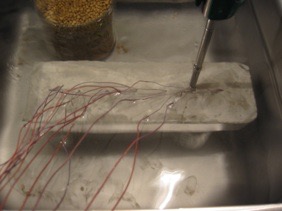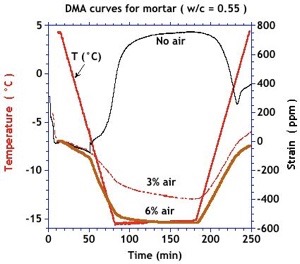
Freezing Experiments

Thermocouples are embedded in cement paste sample, which is then frozen. As the ice propagates, the latent heat increases the internal temperature of the sample. The temperature change of the thermocouples can be used to study ice growth rate.

Volume change of mortar sample is measured by DMA as the temperature drops. The sample without air expands after freezing, due to both hydraulic pressure and crystallization pressure. The samples with entrained air shrink, due to the cryo-suction effect.

The Gibbs-Thomson effect reveals that the melting (freezing) point of water in a small pore is a function of its size. Thus, from the amount of ice formed (melted) at a certain temperature, we can find the volume in pores with radii between about 3 and 50 nm.
Simulation of dendritic growth
Simulation using the level set method indicates that ice propagates in cement paste in the forms of dendrites. The sample is submerged in a cold bath, so the surfaces remain cold as ice forms. The ice grows quickly along the cold edge, then propagates inside. The latent heat will increase the internal temperature of the sample, until heat flow controls the grow rate.
In this simulation, the surfaces of the sample are thermally insulated, so the growth of the dendrites is regular.
Research Interests
I am currently a graduate student in Prof Scherer’s group. I have been working on the project investigating internal frost damage of concrete. Topics I have studied include ice growth in cement paste (numerical simulation (video1) and Helmuth experiments (pictures)), the volume change of mortar during freezing (DMA figure), and the pore structure of mortar (DSC figure).
My general research interest includes numerical simulation and experimental investigation on topics related to durability of construction materials, sustainable materials, and multi-scale analysis.
My work is supported by NSF Grant CMS-0509986.
Publications